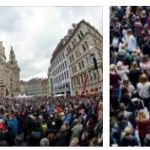Central European state. Sixty years after the disastrous outcome of the Second World War, which in fact reduced it (and relegated it for a long period of time) to a state of not fully sovereign state, Germany has returned to being an actor of the very first magnitude in the political and, above all, European and world economic chessboard. Despite the heavy situation, which lasted for several decades, of a country not only defeated but also occupied, divided into two separate sections, deprived of its historic capital (and its largest metropolis) and the right to dispose of its own army, it managed to to fully regain its role as an ‘economic giant’, to completely reorganize its territory, to proceed, favored in this by the dissolution of the Soviet Union, to the reunification of its two parts. Reunification, which represented the most important episode in the history of the country between the end of20th century and the beginning of the 21st century, due to its high symbolic value and the need for the reconstitution of a national economic space, was also the episode experienced with the greatest difficulty by the German people; especially from that of the Länder Western countries, which found itself having to manage a significantly larger territory than that of the previous forty years, including a sector characterized by a completely different and very backward economy: a body in many respects foreign, whose integration has come to arise, for the new Germany, as a sort of ‘oriental question’. Furthermore, if the Germany until the early 1990s combined the characteristics of an economic giant with those expressed by the picturesque definition of ‘political dwarf’, by now it has regained an undisputed political authority at world level and within the major international organizations: This is proved, among other things, by the fact that in the various UN revision proposals that have followed one another since the last years of the 20th century, the country is almost always among the permanent members of the Security Council.
With its 82,689,000 residents, according to official government estimates for the year 2005, Germany remains by far the most populous European state (excluding the Russian Federation). By surface, however, always excluding Russia, it ranks only in fifth place, after Ukraine, France, Spain and Sweden. The result is a very high territorial density (over 230 residents / km 2, more than double the European average), surpassed by very few other European countries, and among the largest only by the United Kingdom. This large demographic mass, however, is on the whole insufficient for the human resources needs of an economically dynamic country such as Germany, in which, as in all mature societies, the demographic transition has already been completed since the mid-1990s. In fact, in the last years of the twentieth century there was zero growth and immediately thereafter (early 21stCentury) to the decrease in population in absolute terms, as well as to a very mature demographic framework, with a decidedly modest percentage of young people. In reality, the natural balance was negative since the early 1990s, with a birth rate of just over 9.7 and a death rate of almost 10.5 ‰; and the slight increase that lasted for a few years and the subsequent containment are due to the social balance: that is to say to the traditionally substantial immigration influx, which produced a mass of immigrants of almost 7.4 million (2003). The ethnic composition of this large foreign community has significantly varied over time: in the years following the Second World War – especially the years of the ‘German miracle’, the 1960s, when it was a question of rebuilding from scratch the entire industrial apparatus – the Italians clearly prevailed, followed by the Spaniards, Portuguese and Greeks; later, the migratory wave from Italy and the Iberian countries decreased significantly, another one formed, and rapidly grew, fed by migrants from Yugoslavia and then from the republics born from its dissolution; later by Maghrebians and, above all, Turks, the latter soon becoming the clearly dominant component; lastly, after the opening of the borders of the Eastern states, citizens of those countries began to flow in, particularly the Poles.
In 2003, according to EHUZHOU, immigrants from Turkey amounted to about 2 million; it is estimated that just under half of them were of Kurdish ethnicity, which confirms the multiplier effect exerted by ethnic conflict on the tendency to emigrate. The immigration flows were accompanied by massive population transfers within the country, from the most backward Länder eastern in western ones (especially in North Rhine-Westphalia, Baden-Württemberg, Hesse, Bavaria): in fact, a ‘legal’ continuation of the clandestine ones that occurred through the artificial border between the two Germanys. This internal migration did not solve the existing problems (the lack of coverage of jobs on the one hand, and unemployment on the other) and ended up creating more, also due to the rapid adaptation of newcomers to the German social model. Western, consumerist and largely protective, with consequent economic problems and reactions in electoral orientations that penalized the political leadership.
The distributive and settlement characteristics of the population remain more or less unchanged, with a density that, apart from that, obviously completely anomalous, of the three totally urban Länder of Berlin, Hamburg and Bremen, varies from 530 residents / km 2 in North Rhine -Vestfalia to the 75 residents / km 2 of Mecklenburg-Vorpommern. Saarland, Baden-Württemberg, Hesse and Saxony also exceed the average density (the only one among the eastern Länder ; the others report the lowest values ever). Germany, as is known, is one of the most urbanized countries in the world: the urban population in 2003 amounted to 88%, a value, in Europe, exceeded only by Belgium and, slightly, by the Netherlands and the United Kingdom. The most urbanized part of the territory is that which, simplifying, can be defined as ‘Rhine’ and which includes almost the entire Länder of North Rhine-Westphalia, Rhineland-Palatinate, Baden-Württemberg, Hesse and Saarland, overflowing into Lower Saxony and Bavaria. Centered on the Rhine axis, it substantially coincides with the Rhine-Ruhr area, continuum urban that welcomes about fifteen million residents and which is part of the megalopolis formed in Western Europe and extended from England to Switzerland through the Benelux countries, north-eastern France and a large part of Germany. The Rhine-Ruhr is the result of the merger of the Ruhr conurbations, which developed west-east along the valley of the Rhine tributary of the same name and made famous by its coal mines and heavy industry centers (but in the latter part of the twentieth century all transformed; see below: Economic conditions), with the long urban appendix, developed in a north-south direction along the Rhine, from Düsseldorf to Bonn and dominated by the city of Cologne. The Rhine-Ruhr area also connects that of the cities of the lower Main.
The distinctly polycentric model that characterizes this Germany renana, where urbanization has also taken on such showy and all-encompassing shapes and dimensions, explains the fact that the most populous German metropolises are, if considered individually, mostly located in other areas of the country. Of the four largest only Stuttgart (587,000 residents in the city and 2,650,000 in the entire urban agglomeration) is on the edge of the Rhine area; Berlin (3,392,000 in the city and 4,200,000 in the agglomeration), Hamburg (1,700,000 and 2,600,000) and Munich (1,228,000 and 1,950,000) are respectively decentralized towards the north-eastern, northern and southern ends of the national territory (the figures relating to agglomerations refer to 2005, those relating to cities to 2003).
Since the reunification, the fervor of renewal of the German cities, and in a very particular way of Berlin, has been remarkable. The ancient Prussian metropolis, after decades of division, and in many aspects of depression, returned to being the capital (fully only in 1999, when it resumed hosting the federal parliament), posing, among other things, the problem of reconversion of the functions of Bonn, the average city that had long substituted it, very dignifiedly and overall efficiently. Despite its position far from the most economically vital areas of the country and some political-administrative problems posed by relations with Brandenburg, from whose territory the Land urban is totally surrounded, Berlin, in addition to renewing its appearance with the contribution of some of the major architects in the world, is regaining a plurality of urban functions, especially cultural ones, which make it foresee in the near future its promotion to a role of European ‘global city’, not inferior, albeit with different characteristics, to that of London and Paris.








